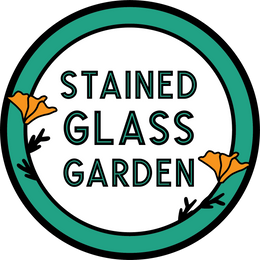The idea of weaving glass is enticing because it tests our conventional knowledge of how glass wants to behave- how do you bend that?! Do they really intertwine like a traditional weave, or is it just an illusion?

Glass of course, is the most versatile artistic medium-in that it can be worked with hot, cold, or in between. However, when it’s malleable, it must be at temperatures above 1500 degrees fahrenheit, which not only is extremely hot(!) but gives way to gravity and all shaping must be planned carefully. When it is cold, it is rigid and does not bend. Therefore, weaving is done with a combination of “Warm Glass” techniques, which include bending, or “slumping” the glass, in combination with cold cut strips. The idea is simple enough, but with multiple products on the market available to assist, many of which are available here at SGG, it becomes a question of how to go about it. So, I set out on a journey to find out just which approach and materials would be best. I shared my findings with the members of our Fusing Lab class, and thought I’d share it here as well. Here’s the concept:

First of all, the initial firing of glass strips to be woven entails slumping over a mold of evenly spaced “humps”, so the glass comes out in uniformly squiggly lines. After that, each squiggle is lined up and every other one is flipped over, creating a hole between two squiggles. This is like a little tunnel for the straight glass strips to travel through in the actual “weaving” portion of your project. So, the question is: Which mold do I use?

We sell two types of ready-made weaving molds perfect for this project: stainless steel and ceramic. The benefit of both is that they are already spaced perfectly, and can be used over and over again. My first discovery was that in order to get my weave past the “sharp edge” stage, I needed to go over temperatures of 1325 degrees, which is hotter than a traditional slump. And in order to get the glass to fully take on the shape of the mold, I found that going all the way up to a “Tack” temperature (1375) was ideal. This means that my mold needs to be treated with ZYP spray every firing, instead of kiln wash. So, which mold do I use? Steel molds are always pricier in general, and requires more ZYP (Boron Nitride) spray to cover each time. But it will ultimately last longer, and is available in a larger size (9x9) than it’s ceramic counterpart, which is 6x6”. They both do the same job. My advice is, if you want to make smaller pieces: 5” square dishes, pot-holders, coasters, elements for other projects, or small wall pieces- get the ceramic mold. The other benefit is, you can fit more than one mold in an average kiln, so you can make more color combos in one firing. But, if you want to really get into woven plates, and do A LOT of them and have a mold that you invest in for the long run because it doesn’t build up residue the way that ceramic molds do, get the stainless steel version. However, if you want to try this technique out a couple of times before investing, you may want to make your own mold. Read on….

We sell a variety of ceramic fiber materials in-store, including Fiber blanket & Duraboard. I constructed a trial with each. I laid 1/2”x1/2” strips about 3/4” apart (which, if you're using 1/8” thick glass, allows for an evenly sized squiggle on both the top and bottom of the glass after the first firing, when you account for the thickness of the glass. This was easier to do with Duraboard, since it is already 1/2” thick. It required less stacking material and was therefore the most cost-effective way to go. Also, because it’s a more rigid product, it stays stiffer after firing and therefore can be used more than once. So this is an easy one- use Duraboard! (You don’t technically have to apply wash to it, but it definitely releases cleaner if you do, so again, I’d just give a little once-over of ZYP.) Now, you can make at least 3 rounds of squiggles. Even better, it comes up to 12” long, so you can control your own weave creation size!

After your mold is selected & prepped, cut 1/2” strips and tack at 1375. Then, clean, flip every other one, and insert straight strips into the “tunnels”. Fire all together once more at a “Tack” temperature, and Voila! You’ve woven glass!
Fun variations: insert copper wire loops in order to make a wall hanging, or slump it to create a plate. I showcase one in a shadowbox in my livingroom, and it inspires a lot of “How did you DO that!!??” ….it can be our secret. :)

Come in to SGG or join our Fusing Lab and find out more. See you soon!

